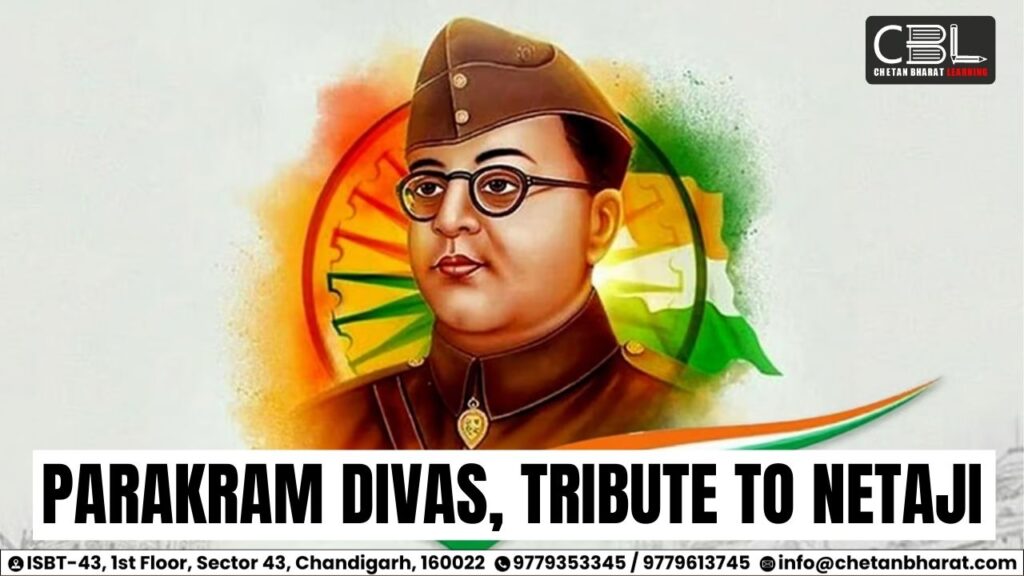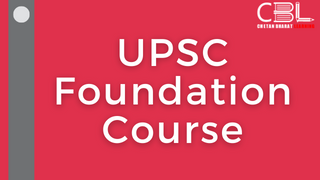
Important for UPSC, State PCS
Prelims: Freedom Struggle and Nationalism
Mains: General Studies Paper 1 – Indian National Army (INA), Bose’s Ideology and Vision ,
Context-
Parakram Diwas, celebrated on January 23 each year, pays homage to the indomitable spirit of Netaji Subhas Chandra Bose, one of India’s most iconic freedom fighters. This day marks the birth anniversary of Netaji, who inspired millions with his unyielding patriotism and relentless pursuit of independence. In 2025, the nation will celebrate the 128th birth anniversary of this legendary leader, emphasizing his unparalleled contributions to India’s freedom struggle .
History of Parakram Diwas
Born on January 23, 1897, in Cuttack, Odisha, Netaji was a visionary leader who challenged British colonial rule with unwavering determination. A brilliant student, Bose qualified for the Indian Civil Services (ICS) but chose to join the Indian National Movement under the leadership of Mahatma Gandhi. However, his radical approach and call for armed resistance often set him apart from mainstream leaders.
In 1943, Netaji formed the Azad Hind Fauj (Indian National Army) and aligned with Axis powers to fight against British rule. His famous slogans, such as “Give me blood, and I will give you freedom,” continue to resonate with patriotic fervor. Recognizing his immense contributions, the Government of India declared January 23 as Parakram Diwas in 2021, a day to honor his valor and selfless service to the nation….
Netaji Subhas Chandra Bose’s Contribution to Freedom Struggle
Netaji Subhas Chandra Bose played a pivotal role in India’s fight for independence. His contributions are unparalleled and reflect his revolutionary approach:
- Presidency of INC: Bose became INC President in 1938 (Haripura) and 1939 (Tripuri), but resigned due to differences.
- Establishment of Forward Bloc: In 1939, he founded the Forward Bloc to unite the political left and gain support in Bengal.
- Formation of the Indian National Army (INA): Bose led the INA to fight against British forces during World War II.
- Proclamation of Azad Hind Government: In October 1943, he declared a provisional government, highlighting India’s right to self-rule.
- International Alliances: He sought support from Axis powers during WWII to strengthen India’s fight for freedom from British colonial rule.
Famous Quotes by Netaji Subhas Chandra Bose
Netaji’s words reflect his determination and patriotism. His famous quotes continue to resonate with those seeking inspiration in their journeys.
“Give me blood, and I will give you freedom.”
“We should have but one desire today — the desire to die so that India may live.”
“The secret of political bargaining is to look more strong than what you really are.”
“Freedom is not given — it is taken.”
“A light brought into a dark room will necessarily illuminate every portion of it”
The Indian National Army (INA): Formation, Activities, and Legacy
- Inception: The INA was originally envisioned by Mohan Singh, an Indian army officer who sought Japanese support during World War II.
- Initially, the Japanese handed over Indian prisoners of war (POWs) to Mohan Singh, who attempted to recruit them into the INA.
- With the fall of Singapore, many Indian POWs were willing to join the INA, and by the end of 1942, around 40,000 men were ready to participate.
- The INA’s first division was formed in September 1942, with 16,300 men, coinciding with the Quit India Movement.
- Subhas Chandra Bose took over the leadership of the INA in 1943 and formed the Provisional Government for Free India in Singapore.
- The provisional government declared war on Britain and the United States and was recognized by the Axis powers.
- The INA created various regiments, including the Rani Jhansi Regiment for women.
- INA troops crossed into India in 1944 with the slogan “Chalo Delhi!” but had to withdraw as the Japanese retreated.
- The INA’s fate was sealed with Japan’s surrender in August 1945, and many members were taken prisoner.
- Subhas Chandra Bose’s death in an air crash in 1945 marked the end of the INA’s activities, but the soldiers’ court-martial upon their return to India sparked a powerful movement in their defense.
Subhash Chandra Bose Aapda Prabandhan Puraskar 2025
The Subhas Chandra Bose Aapda Prabandhan Puraskar is awarded annually to individuals and organisations for their contributions to disaster management in India. The award is announced every year on January 23, coinciding with Netaji Subhas Chandra Bose Jayanti. There are two main categories for the award:
- Institutional: Winners receive a cash prize of ₹51 lakh and a certificate.
- Individual: Winners receive a cash prize of ₹5 lakh and a certificate.
For the year 2025, the award was conferred upon the Indian National Centre for Ocean Information Services (INCOIS), Hyderabad. This award reflects Netaji’s spirit of leadership and service, encouraging proactive disaster management initiatives.
CBL Practice Questions for Prelims-
Consider the following statements regarding Netaji Subhas Chandra Bose:
- Netaji Subhas Chandra Bose was the founder of the Indian National Army (INA) and led it against British forces during World War II.
- Parakram Diwas, observed on January 23, commemorates his birth anniversary and honors his contributions to India’s independence movement.
- Netaji Subhas Chandra Bose was associated with the formation of the Azad Hind Government in 1943, which sought to establish an independent India.
Which of the above statements is/are correct?
A) 1 and 2 only
B) 2 and 3 only
C) 1, 2 and 3
D) 1 only
Answer: C) 1, 2 and 3
CBL Mains Practice Question-
“In 2025, India will celebrate the 128th birth anniversary of Netaji Subhas Chandra Bose on Parakram Diwas. How does his legacy continue to influence contemporary India’s political and nationalistic discourse?”




Leave a Reply
You must be logged in to post a comment.